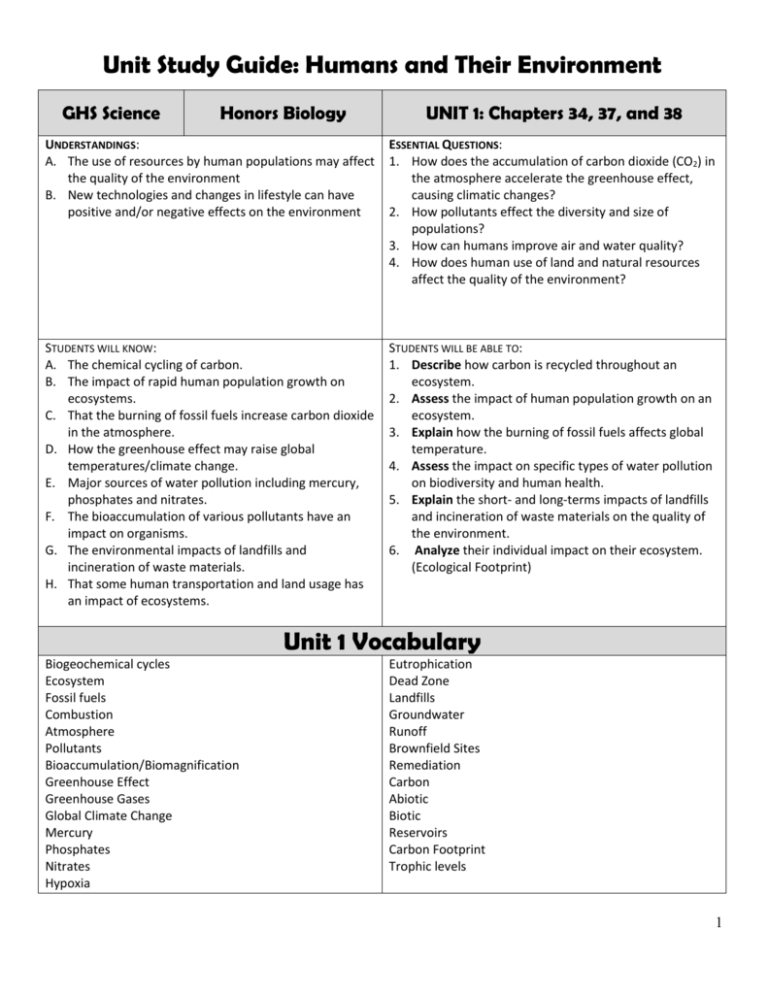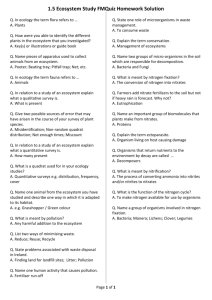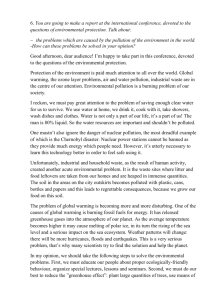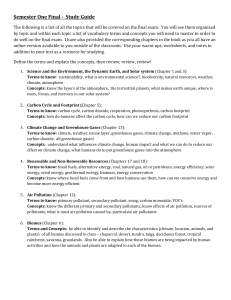USG Unit 1 - Global Interdependence 2015 2016
advertisement

Unit Study Guide: Humans and Their Environment GHS Science Honors Biology UNIT 1: Chapters 34, 37, and 38 UNDERSTANDINGS: A. The use of resources by human populations may affect the quality of the environment B. New technologies and changes in lifestyle can have positive and/or negative effects on the environment ESSENTIAL QUESTIONS: 1. How does the accumulation of carbon dioxide (CO2) in the atmosphere accelerate the greenhouse effect, causing climatic changes? 2. How pollutants effect the diversity and size of populations? 3. How can humans improve air and water quality? 4. How does human use of land and natural resources affect the quality of the environment? STUDENTS WILL KNOW: A. The chemical cycling of carbon. B. The impact of rapid human population growth on ecosystems. C. That the burning of fossil fuels increase carbon dioxide in the atmosphere. D. How the greenhouse effect may raise global temperatures/climate change. E. Major sources of water pollution including mercury, phosphates and nitrates. F. The bioaccumulation of various pollutants have an impact on organisms. G. The environmental impacts of landfills and incineration of waste materials. H. That some human transportation and land usage has an impact of ecosystems. STUDENTS WILL BE ABLE TO: 1. Describe how carbon is recycled throughout an ecosystem. 2. Assess the impact of human population growth on an ecosystem. 3. Explain how the burning of fossil fuels affects global temperature. 4. Assess the impact on specific types of water pollution on biodiversity and human health. 5. Explain the short- and long-terms impacts of landfills and incineration of waste materials on the quality of the environment. 6. Analyze their individual impact on their ecosystem. (Ecological Footprint) Unit 1 Vocabulary Biogeochemical cycles Ecosystem Fossil fuels Combustion Atmosphere Pollutants Bioaccumulation/Biomagnification Greenhouse Effect Greenhouse Gases Global Climate Change Mercury Phosphates Nitrates Hypoxia Eutrophication Dead Zone Landfills Groundwater Runoff Brownfield Sites Remediation Carbon Abiotic Biotic Reservoirs Carbon Footprint Trophic levels 1 1. Ecologists study how organisms interact with their environment at several levels. Define each of these four levels and provide an example. (Textbook page 680) _____________________________________________________________________________________________ _____________________________________________________________________________________________ _____________________________________________________________________________________________ _____________________________________________________________________________________________ _____________________________________________________________________________________________ _____________________________________________________________________________________________ _____________________________________________________________________________________________ _____________________________________________________________________________________________ _____________________________________________________________________________________________ 2. What factors influence life in a biosphere? On your response, be sure to include and define the terms biotic, abiotic, physical factors, and chemical factors. (Textbook pages 680-683) _____________________________________________________________________________________________ _____________________________________________________________________________________________ _____________________________________________________________________________________________ _____________________________________________________________________________________________ _____________________________________________________________________________________________ _____________________________________________________________________________________________ _____________________________________________________________________________________________ 3. Describe how organisms are related to one another in a food chain. Identify and discuss each trophic level using the terrestrial food chain provided to the left. How much energy is retained at each step? How does primary production play role? (Textbook pages 744-745, 750-753) _____________________________________________________________________________ _____________________________________________________________________________ _____________________________________________________________________________ _____________________________________________________________________________ _____________________________________________________________________________ _____________________________________________________________________________ _____________________________________________________________________________ _____________________________________________________________________________ _____________________________________________________________________________ _____________________________________________________________________________ 2 4. Define atmosphere and describe what it does for our Earth. _____________________________________________________________________________________________ _____________________________________________________________________________________________ _____________________________________________________________________________________________ _____________________________________________________________________________________________ 5. a) b) c) d) Diagram the carbon cycle. (Textbook page 753, 767) How does carbon enter a deer’s body? Identify two ways this element can leave the deer’s body. What two processes keep the levels of CO2 constant in the biosphere normally? How have humans altered the cycling of carbon? 6. What is the greenhouse effect? In your response, be sure to define and provide examples of greenhouse gases. How does the combustion reaction play a role? (textbook pages 766 – 769) _____________________________________________________________________________________________ _____________________________________________________________________________________________ _____________________________________________________________________________________________ _____________________________________________________________________________________________ _____________________________________________________________________________________________ _____________________________________________________________________________________________ _____________________________________________________________________________________________ _____________________________________________________________________________________________ 3 7. Ice sheets have one particularly special property. They allow us to go back in time and to sample accumulation, air temperature and air chemistry from another time. Ice core records allow us to generate continuous reconstructions of past climate, going back at least 800,000 years. By looking at past concentrations of greenhouse gasses in layers in ice cores, scientists can calculate how modern amounts of carbon dioxide and methane compare to those of the past, and, essentially, compare past concentrations of greenhouse gasses to temperature. Evaluate the data below. Identify two CLAIMS that can be made from the data and support them with EVIDENCE. _____________________________________________________________________________________________ _____________________________________________________________________________________________ _____________________________________________________________________________________________ _____________________________________________________________________________________________ _____________________________________________________________________________________________ _____________________________________________________________________________________________ _____________________________________________________________________________________________ _____________________________________________________________________________________________ _____________________________________________________________________________________________ _____________________________________________________________________________________________ _____________________________________________________________________________________________ _____________________________________________________________________________________________ _____________________________________________________________________________________________ _____________________________________________________________________________________________ _____________________________________________________________________________________________ 4 8. Diagram the water cycle. Be sure to include and define the following terms: precipitation, condensation, evaporation, radiation, infiltration, aquifer, transpiration, and runoff. (Textbook page 695) 9. How does global climate change impact the water cycle? _____________________________________________________________________________________________ _____________________________________________________________________________________________ _____________________________________________________________________________________________ _____________________________________________________________________________________________ _____________________________________________________________________________________________ _____________________________________________________________________________________________ _____________________________________________________________________________________________ _____________________________________________________________________________________________ _____________________________________________________________________________________________ _____________________________________________________________________________________________ 5 10. Diagram the nitrogen cycle. (textbook pages 754-756) a) Nitrogen is required for the synthesis of which organic compounds? b) Explain how atmospheric nitrogen makes its way into a mammal. Identify the chemical forms of nitrogen involved, the reactions that convert nitrogen from one chemical form to another, and any microorganisms required for each chemical conversion. c) Explain how the nitrogen in organisms is converted back into atmospheric nitrogen. d) Why do farmers frequently include legumes as part of a crop rotation? e) Why do farmers frequently use commercial fertilizers to increase the yield of their crops? 6 11. How is hypoxia caused? In your explanation, include the terms eutrophication, nitrates, phosphates, decomposers, and algae bloom. (textbook 756) __________________________________________________________________________________________ __________________________________________________________________________________________ __________________________________________________________________________________________ __________________________________________________________________________________________ __________________________________________________________________________________________ __________________________________________________________________________________________ __________________________________________________________________________________________ 12. For each of the specific types of water pollution listed below, make a table to help organize your explanation of its specific impact on biodiversity and human health. Type of Pollution Major Source (Where does it come from?) How does it enter the ecosystem? (i.e. runoff, leaching, etc…) Identify one specific technological solution that reduces the impact of this type of pollution. DDT Dirt/Sediment Mercury Nitrates Phosphates 13. Name and explain the concept illustrated in the image to the right. How are the small fish affected in comparison to the large fish? Justify your answer. __________________________________________________________________ __________________________________________________________________ __________________________________________________________________ __________________________________________________________________ __________________________________________________________________ __________________________________________________________________ __________________________________________________________________ 7 14. What is a Brownfield Site? __________________________________________________________________________________________ __________________________________________________________________________________________ __________________________________________________________________________________________ 15. How and why should a brownfield site be remediated? What are the benefits to having remediated land available? __________________________________________________________________________________________ __________________________________________________________________________________________ __________________________________________________________________________________________ __________________________________________________________________________________________ __________________________________________________________________________________________ 16. List two direct effects of human population growth on an ecosystem. __________________________________________________________________________________________ __________________________________________________________________________________________ __________________________________________________________________________________________ __________________________________________________________________________________________ __________________________________________________________________________________________ 17. If you had a choice, would you prefer a landfill or incinerator in your neighborhood? Please explain the reason for your choice in terms of how the solution is engineered to minimize pollution and its specific impact on human health and the environment. __________________________________________________________________________________________ __________________________________________________________________________________________ __________________________________________________________________________________________ __________________________________________________________________________________________ __________________________________________________________________________________________ 18. What is a carbon footprint? List 5 ways you can personally reduce your footprint. __________________________________________________________________________________________ __________________________________________________________________________________________ __________________________________________________________________________________________ __________________________________________________________________________________________ __________________________________________________________________________________________ 8








